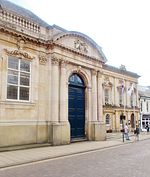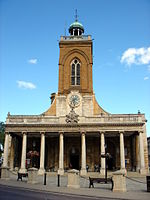West Northamptonshire

West Northamptonshire is a local government district in the ceremonial county of Northamptonshire, England, created in 2021. West Northamptonshire Council is a unitary authority, being a district council which also performs the functions of a county council. By far the largest settlement in West Northamptonshire is the county town of Northampton. Its other significant towns are Daventry, Brackley and Towcester; the rest of the area is predominantly agricultural villages though it has many lakes and small woodlands and is passed through by the West Coast Main Line and the M1 and M40 motorways. The district includes the site of the Roman town of Bannaventa, and the grade I listed Althorp House and its estate.
Excerpt from the Wikipedia article West Northamptonshire (License: CC BY-SA 3.0, Authors, Images).West Northamptonshire
Saint Giles Square,
Geographical coordinates (GPS) Address Website Nearby Places Show on map
Geographical coordinates (GPS)
| Latitude | Longitude |
|---|---|
| N 52.237 ° | E -0.895 ° |
Address
The Old Bank
Saint Giles Square 4/7
NN1 1JA , Semilong
England, United Kingdom
Open on Google Maps











